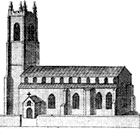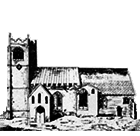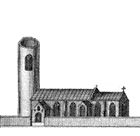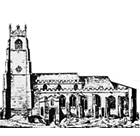 Introduction to the history of medieval
boroughs
Introduction to the history of medieval
boroughs Introduction to the history of medieval
boroughs
Introduction to the history of medieval
boroughs
| Urban society |
The essential role of towns within the economic fabric of England should not let us downplay their importance as social institutions. Man is, after all, a social animal, and urban environments were shaped to provide for human social needs, just as much as they were shaped to provide for political needs, in terms of organizing, controlling and directing groups of people. It is natural enough for people living in close proximity to form a community not just in the sense of a defined physical space but a group sharing similar interests and values, which in turn are expressed through a set of rules and institutions that direct acceptable behaviour. But thinking of urban society as communal should not blind us to the fact that it was not only economically heterogeneous, it was also marked by social heterogeneity. That is, comprising people whose social standing varied widely and who formed different types of association based on factors such as neighbourhood, ethnicity, economic self-interest, mutual support, or common beliefs or aspirations; so that towns can be imagined as a complex patchwork of overlapping communities. This heterogeneity was naturally more pronounced and more conspicuous in the major towns with larger populations.
None of this is to say that town-dwellers were socially distinct from rural folk in the Anglo-Saxon period, nor that they were later anomalies in a feudal society, notwithstanding that the classic medieval division of society into those who fought, those who prayed, and those who laboured does not seem to make much provision for the merchant class. Part of Pirenne's hypothesis of the emergence of towns in eleventh century was based on the notion of "wandering traders" settling down to form the core of urban society; his chief example was an English trader named Godric, but no evidence of other examples has yet been found in England. One of the key questions, therefore, is how did a merchant class emerge?
Towns and villages were rooted in the same traditions, the same forms of social organization (e.g. clans, gilds, tithings, parishes), and it was largely from the countryside that towns built and replenished their populations; as already noted, probably a majority of townsmen in most places continued to engage to some degree in agricultural activities. Even though we hear of "burhmen" and "portmen" in the Late Anglo-Saxon period, town-dwellers probably did not perceive much difference between themselves and their rural neighbours, in terms of their overall view of society. While the Norman Conquest influenced the urbanization process through the changes wrought on many leading towns by the introduction of castles and cathedrals, on the established fundamentals of urban society the Conquest had only minor effects.
The differentiation of urban and rural society becomes more clearly defined only with the grants of special privileges, including a degree of personal freedom, from about the twelfth century onwards. Although this may be partly the historian's perception, stemming from the fact that documentation of urban communities improves greatly in the period following such grants, it was in conjunction with the development of local government that the economic and administrative roles of boroughs, and the customs by which inhabitants' lives were governed, became more distinctive. After this, "burgess" seems to have become a more technical term – although inconsistency in its application from place to place, time to time, writer to writer, makes this difficult to pin down; even Domesday Book's use of "burgess" has seemed to some to intend a distinction from other types of residents of towns, although again the evidence is open to interpretation.
By the twelfth century, however, urban society had already become fairly structured; it was characterized by diversity – the leading burgesses (who are the most visible in historical records) cannot be described as a merchant class, even if we follow medieval practice in using "merchant" broadly to include small retailers as well as wholesalers. While most towns drew the majority of their immigrants from the neighbouring countryside – large cities attracting from further afield, and London being a magnet for the ambitious from all parts of the country – these were not necessarily poor peasants seeking to make their fortunes, and still less were they the "fugitive serfs" of Victorian tradition (visible examples of such are not common). Rather, they included people already active in trade or craft, seeking to move to where there was a larger market. They included scions of landed families, some of whose property might already be in or adjacent to the town. They included at least a small number of individuals earning their livelihood from administrative or other services. In towns such as Colchester and Ipswich we find evidence that some burgesses based their wealth and social status on landholding; whereas in coastal towns commerce was a more important source of wealth and these locations (e.g. Lynn) and some of the merchants who visited to trade decided to settle. The diversification was therefore not only one of occupation but one of culture, and was furthered in a number of the larger towns by an influx of Normans after the Conquest, and of Jews in the twelfth century – although it is unclear to what extent their communities integrated with urban society before the expulsion of Jews from England in 1290.
It is dangerous to talk of "class" in the medieval context; yet, although we must avoid some of the modern (largely Marxist) connotations attached to the term, we cannot avoid it. To imagine urban society as egalitarian would be to ignore its essence. It is clear that within the towns there was the perception of a tripartite division between the "lesser", "middle" and "powerful" townsmen. The contexts in which we find this perception expressed, however, suggest that the differentiation was a somewhat vague one of wealth, associated with political power. It would be a mistake to translate it into an occupational division of labourers, craftsmen and merchants (even though that might, in very general terms, be more accurate than not), or to assume that the powerful townsmen formed a patriciate with an exclusivist grip on local government (although, again, this is not entirely without foundation), or again to think of these divisions as closed castes – social mobility was both possible and necessary.
Nor is it clear whether the concept of "community" encompassed all three groups, or whether the lesser townsmen were residents who did not benefit from the chartered privileges. Perhaps from the time that such privileges were acquired (as the Ipswich evidence implies), "burgess" began to acquire a more restricted application comparable to citizenship in twentieth-century nation-states: membership had to be acquired by a specific act, which might be birth as the son of an existing citizen, purchase, or (later) completion of apprenticeship to a citizen. We need not read anything sinister into this; it seems a natural enough application of the common notion that rights and responsibilities go hand-in-hand. Unfortunately, our present state of knowledge of individual towns does not allow us to determine whether terms like "community" and "burgess" had the same meaning everywhere or at different periods.
 |
|
Depiction of a feast, from the tomb brass of Robert Braunch; perhaps intended as the merchant gild of Lynn, of which Robert was a member, feasting in Trinity Hall, its walls hung with star-emblazoned cloths. The symbolic 12 participants, dining on delicacies, entertained by minstrels, and several in lively conversation, should not be thought to represent specific townspeople; although it has been suggested that the depiction is of a feast at which the gild hosted Edward III, this is unlikely, even though the king often came to nearby Castle Rising to visit his mother. We must allow for a certain amount of invention by the Flemish engraver in carrying out the terms of his commission. However, the choice of a peacock feast, which had a ritualistic dimension, as the theme may have been intended to symbolize Adam's sense of fellowship and solidarity with other gildsmen who were community leaders. |
Complicating the picture are medieval gilds. The first gilds in towns were probably formed for social and religious association. They and their successors seen in the Late Middle Ages may have cross-cut class divisions to some degree, although in the latter period membership fees may served exclusivist purposes as the wealthiest townspeople sought to associate more with country gentry than with lesser townsfolk. More important, gilds – not a solely urban institution – transformed in the urban context to represent different economic interests. Thirteenth-century evidence from Lynn and Ipswich suggests that a large part of the populace belonged to the merchant gild, at a time when that was likely the principal institution representing community aspirations. As community-based government grew, merchant gilds might become redundant and disappear (or perhaps merge into local government) or become restricted to true mercantile interests within the town, while the interests of others – notably craftsmen – sought expression through their own gilds, each representing either one craft or a group of related crafts. These various interests were not always in harmony, provoking efforts at first to suppress and, when suppression failed, to control them through regulation.
The violent conflicts recorded in various towns between late twelfth and fifteenth centuries have sometimes been portrayed as a gild-based struggle between merchants and craftsmen; yet the concerns or grievances that gave rise to such conflicts seem for the most part more related to the conduct of local government than economic control (although the two cannot be easily separated). Whether such conflicts represent political struggles between democratic and oligarchic factions I have elsewhere explored in detail and will not revisit here except to say that medieval townsmen were far less concerned with political ideology than they were with honest, fair and beneficial government; it was natural for the reins of government to fall to the wealthier burgesses, and equally natural that, in some cases, self-interest or group interest factored into the conduct of government. Medieval urban government was, in many of its fundamentals, not so different from that of our own time.
Government is rarely an easy task; in its efforts to balance interests, the hard decisions that have to be made rarely find total support within a community. It would be a mistake to take the evidence of socio-political conflicts, which feature disproportionately large in surviving records (predominantly judicial), and visualize an urban environment in which discord was the norm. Then, as today, good news is no news. It may be that problems – such as finding the revenue to pay for the growing list of responsibilities of local government – increased and tensions rose from the late fourteenth century on, as the economy declined and there was greater competition for a piece of a shrinking pie; but since economic conditions varied from one part of the country to another, we cannot generalize.
Expressions of discontent within urban society are as likely to have been result of local circumstances (e.g. misgovernment) as much as any broader trend. However, there are signs in the fifteenth century of some closing of ranks in the ruling class, in the direction of the post-medieval closed corporation, assisted by constitutional changes which confined democratic tendencies by institutionalizing them and by the direction of royal policy regarding the integration of the towns into a system of national administration. The urban rulers relied more on social and political ceremonies – such as feasts, processions, official greeting of visiting dignitaries, swearing-in of borough officials – intended at once to reinforce community identity and pride in membership, while demonstrating social distinctions and precedences within the community.
Before concluding, it must be acknowledged that much of the terminology used in referring to townspeople is male-oriented. As for many periods of history, males figure much more heavily in the historical record than females, and the study of women's history has only in recent years begun to examine the limited evidence related to female roles in medieval towns. Marriageable women were their fathers' tools for social, political or economic alliances; sometimes a way for a wealthy merchant to establish links with the gentry. Married women did not have much legal status independent of their husbands, although in some regards this was less so within towns than outside. Some examples of this (varying from town to town) are that the property that a woman brought into a marriage could not safely be disposed of by her husband without his wife's freely-given consent; a woman (if childless) might bequeath such property to whomever she chose, allowing for a surviving husband's lifetime right; similar provision was made for widows to ensure their lifetime continuance in the marriage residence.
There seems to have been no provision for women to become burgesses in the technical sense of being admitted to the freedom and acquiring rights of participation in political life. On the other hand, there are some indications that they shared with their husbands in the commercial advantages of citizenship and retained such rights as widows; they could undertake business contracts in their own right. They might learn enough of their husband's business to be of assistance; although this would not go so far as for them to travel as merchants (widows used factors or apprentices for this), women were quite prominent among producers and retailers of ale and some other prepared foods – a reflection of the entrepreneurial attitude of townspeople, making money in whatever ways they might. Among the few records that give any detail about them are their testaments and documents related to charitable foundations – another activity in which they were quite prominent. Single women, on the other hand, often had to eke out an existence as small-scale traders, domestic servants, or prostitutes.
This leads us to a final topic needing to be touched upon in this brief introduction to some of the main themes and issues of the medieval history of English towns, and that is the role of religion in the life of townspeople. This was structured initially through the parish system, which was shaped and reshaped in response to shifting population density. Parish churches played an important role in town life, as the earliest public buildings serving secular uses and of course as the focus of spiritual life of the community. The association with many socio-religious gilds with one or other church, and the late medieval penchant for the private foundation of chantries and large donations to expand and beautify parish churches (an expression of civic pride), are examples of this. Other religious foundations were also important elements in urban history and urban society: the friaries were very popular with townspeople and another target of charitable donations; by contrast, abbeys and monasteries were looked upon with some suspicion as rival sources of jurisdiction. Nor must we forget the hospitals, almshouses and leper-houses which contributed to urban society care-giving to the poor, ill, or aged members of society, and which also relied on the charity of townspeople. It was, however, not just the Church which helped shape towns, but urban society which played a role in shaping Catholic thought, in terms of reconciling moral stricture with the commercialized behaviours and attitudes of townspeople.
 |
 |
 |
 |
| St.
Laurence, Norwich (by Corbridge, 1724) |
St.
Mary Elms, Ipswich (by Ogilby, 1674) |
St.
Mary Coslany, Norwich (by Corbridge, 1724) |
St.
Peter, Ipswich (by Ogilby, 1674) |
For the most part medieval townspeople were conventionally religious; many members of urban families were among the parish priests or locally-based friars, monks or nuns. But they were also worldly. Sometimes their donations or bequests to religious houses were motivated by bad conscience over un-Christian business practices; provisions for charitable bequests were occasionally very elaborate. Similarly, a religious order established within an environment could find itself subject to temptations in appropriate to Catholic spirituality. Although medieval cities, where people from many countries crossed paths, are perceived of hot-beds of heresy this is not so much the case in England. Instances of heresy in English towns are relatively scarce. The Church was not the centre of life in urban society, but it was a valued part and townsmen on the whole were disinclined to jeopardise their investments in the established ecclesiastical fabric.
 previous |
 main menu |
 next |
| Created: April 5, 1999. Last update: September 21, 2016 | © Stephen Alsford, 1999-2016 |